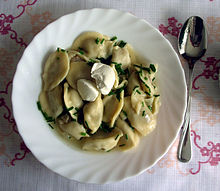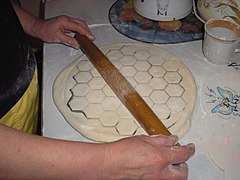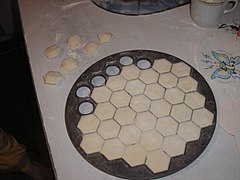Pelmeni

Pelmeni ( Russian пельмени ) are originally from Russia, in water or broth boiled and stuffed with meat dumplings that are either as a soup or as a main dish eating. Today they are among the Russian national dishes and are known in all parts of the country. It is believed that its origin lies in the regions of the Urals, Volga and Siberia. Russian cuisine in these regions is said to be heavily influenced by Asian nomads. Due to historical territorial changes in Ukraine , pelmeni are part of the local Russian-dominated regional cuisine.
Etymology and Distribution
There are several theories about the origin and distribution of the pelmeni. Some cultural historians see them as a variant of the Chinese Jiaozi that were spread by the Mongols . Others consider an origin from Persia to be more likely and the name for a Russification of the term pel'n'an from the language of the Udmurts , a Finno-Ugric people in the western Urals . In this language pel means 'ear' and n'an is a product made from flour; in Persian is nan the name for bread. There should have been cultural connections between the Udmurts and Persia. The dumplings in Persian cuisine are called joshpara . But it is also said that pelmeni originally come from Siberia because they can be frozen and stored for so long.
Similar dumplings are also available in other Eurasian countries . In terms of size between tortellini and tortelloni , they differ from these, the ravioli , the Swabian Maultaschen or the Chinese Jiaozi and Wan Tan through their filling, which consists exclusively of seasoned minced meat without any fillers. The Kreplach and Polish Uszka , which come from Jewish cuisine, hardly differ from Pelmeni ; are also similar to the small, cooked by boiling Mantı as they are cooked in the Middle East. Furthermore, the composition and cooking method of the pelmeni correspond to the Georgian khinkali and largely to the meat-containing variants of the Polish pierogi ( pierogi z mięsem ).
As a result of the immigration of people from Russia or with Russian roots, pelmeni are now also enriching the culinary offer in German-speaking countries , especially in metropolitan areas (e.g. Berlin ). Pelmeni are offered both in the fast food segment (e.g. at takeaways ) and in restaurants ; they are also available for your own home preparation in grocery stores, which also have an offer for Russian or Ukrainian cuisine.
preparation
The dough of the pelmeni consists of flour , salt , water and egg . It is processed into small, round dough sheets in various ways, which are filled with a mixture of minced meat ( pork , beef , other types of meat) with onions, garlic, salt and pepper and carefully sealed. Then the pelmeni are cooked in salted water or a broth for about 5 to 10 minutes, depending on their size. Dumplings with fillings made from potatoes, cabbage or sweet fillings made from cream cheese and berries are called vareniki .
The fastest way to make pelmeni is with a special shape, the so-called pelmenitsa ( Russian : пельменница) , in which the minced meat mixture is placed in heaps between two layers of rolled out dough. Prepared in this way, the dough and meat mass are pressed together with a rolling pin. The pelmeniza has protruding sharp edges on the edges of the holes, which ensure that the raw pelmeni are punched out (see picture gallery below). However, the traditional way of making it entirely by hand is better for the relationship between dough and filling. The dough should always be as thin as possible and the meat mixture should shimmer through the dough as much as possible. For this purpose, the dough is rolled out as thinly as possible and then cut out in a round shape (about 7 to 10 cm in diameter). Each piece of dough created in this way is then covered with the meat mixture and pressed into a semicircle with the fingers so that the edge is kept as small as possible, but the pelmeni are well closed - otherwise they could open during cooking. Then the two “ends” of the semicircle are connected to one another.
Pelmeni are traditionally eaten with smetana (sour cream) , but also with melted butter and with vinegar, salt and pepper.
Pelmeni can be frozen to preserve them. In this form, they are already prefabricated on offer in retail outlets.
- Preparation with the pelmenitsa
literature
- Igor Jurjewitsch Klech : The book about food. Pelmeni and pierogi, borscht and bigos & Co. From the Russian and with an afterword by Tatjana Hofmann. Edition.fotoTapeta, Berlin 2011, ISBN 978-3-940524-12-6 .
Web links
Individual evidence
- ^ Alan Davidson: The Oxford Companion to Food , 2nd ed. New York 2001, article Pel'meni (English).
- ↑ Пельменів не буде - будуть равіолі? ' Retrieved March 26, 2016 (Ukrainian).







